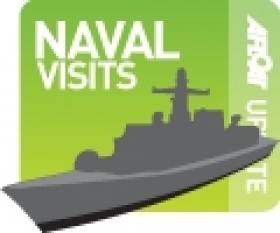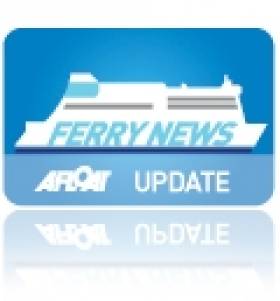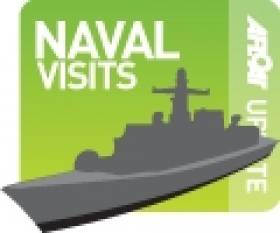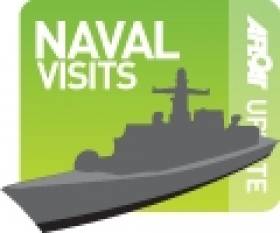Displaying items by tag: Royal Navy
Royal Navy Patrol Craft Dock In Dun Laoghaire Marina
#NavalVisits-A pair of Royal Navy 20m inshore fast patrol boats berthed yesterday in Dun Laoghaire Marina, having previously called to Cork Harbour over the Easter weekend, writes Jehan Ashmore.
HMS Express (P163) and HMS Exploit (P167) with a crew of five each, belong to a 14 strong fleet of Archer P2000 class and they form the First Patrol Boat Squadron. Both vessels are based in Penarth Marina, near Cardiff.
Their primary role is to support the University Royal Naval Units (URNU) but they also contribute to a wide range of fleet tasking. The URNU is based at HMS Cambria, a Royal Navy Reserve establishment near the Welsh capital.
Birthday Bash as HMS Belfast Celebrates 75th Anniversary
#HMSBelfast – The Thames floating landmark, HMS Belfast celebrates its 75th anniversary, coinciding with this weekend's St. Patrick festivities held on both sides of the Irish Sea, writes Jehan Ashmore.
The Town-Class cruiser was launched on St. Patrick's Day 1938 from Harland & Wolff, Belfast. She is one of the last surviving WW2 warships remaining in UK waters. She was commissioned into the Royal Navy the following year and placed under the command of Captain G.A. Scott DSO.
During her career, HMS Belfast opened fire in support of Allied troops during the D-Day landing, was on escort duty during Artic convoys of merchant ships in addition to involvement in the Korean War.
To commemorate the historical significance of HMS Belfast, which has been moored on the Thames since 1971 as a major tourist attraction, a series of special events are to be held this weekend.
Her Belfast-based counterpart, the C-Class light cruiser HMS Caroline, which served in World War I having been built in 1914 at Cammell Laird, Birkenhead, lies on the Lagan.
As previously reported, the fate of the former Battle of Jutland survivor was secured following last year's decision to protect the vessel from falling into disrepair with a £1m restoration grant.
On completion of the work on the veteran vessel now in her 99th year, she is to become a major tourist attraction likewise of HMS Belfast.
Duke Class Frigate to Dock in Dublin Port
#FrigateVisit-The Royal Navy Type 23 Duke Class frigate HMS Richmond (F239) is to make a weekend courtesy call to Dublin Port, with an arrival to the capital this afternoon, writes Jehan Ashmore.
The 4,900 displacement frigate commissioned in 1995 has a top speed 28 knots and a crew complement of 185. She and her 12 sisters are among the most tried and tested in the fleet, having pounded Saddam Husseins defences on the Al Faw peninsula in the opening hours of the Iraq campaign a decade ago in 2003.
HMS Richmond has undergone an upgrade to sensors and weapons systems, where Seawolf Mid-Life Update (SWMLU) are now fitted that will improve the ship's ability to meet the evolving capability of anti-ship missiles. In addition the frigate has 30 mm Automated Small Calibre Gun (ASCG) system making her a formidable and modern weapons platform.
Ferry Cruises to Mark HMS Illustrious Visit to Liverpool
#SightseeingCruise- Special river explorer cruises operated by Mersey Ferries are to run this weekend to mark the visit of HMS Illustrious (R06) to Liverpool.
Onboard the river cruises this weekend 16-17 February, between 11am and 4pm (including 4pm cruise), Blue Badge Guides will be giving passengers live commentaries about HMS Illustrious and the aviation history of the Royal Navy.
For further details visit: www.merseyferries.co.uk/content/Cruises/Cruisedates.aspx
Liverpool’s ‘Lusty’ Valentine Marks Changing Times for Aircraft-Carriers
#AircraftCarriers – The Royal Nay's last 'Invincible' aircraft carrier, HMS Illustrious (R06) affectionately known by her crew as 'Lusty', which these days serves as a helicopter commando-carrier, docked on St. Valentine's Day at Liverpool Cruise Terminal, writes Jehan Ashmore.
As previously reported, during her five-day city courtesy call, she is to be open to the public this weekend. The call to Merseyside could be her last as the 22,000 displacement tonnes vessel is due to pay off in early 2014. She was launched in 1978 from Swan Hunter on the Tyne and over the next 32 years the 209m long vessel has served an illustrious career including her role in carrying 'Harrier' VSTOL jump jets.
The Portsmouth based HMS Illustrious is one of four Royal Navy core amphibious vessels, and in her place are a pair of Queen Elizabeth class 65,000 displacement tonnes aircraft –carriers currently under construction. However until delivered, HMS Ocean (L12) a helicopter carrier of 21,500 tonnes will replace Illustrious, after completion of a £65m refit at Devonport Royal Dockyard early next year.
Former Aircraft Carrier HMS ‘Lusty’ Open to Public Following Valentine Call
#AircraftCarrier- HMS Illustrious (R06) the Royal Navy's helicopter commando carrier is due to arrive in Liverpool on St. Valentine's Day and be open to the public next weekend (16-17 February), as part of a five-day call, writes Jehan Ashmore.
For more than three decades the former aircraft-carrier (equipped with Harrier jump-jets) has served the Royal Navy, however she is to pay-off in 2014, to make way for next generation aircraft-carriers.
Affectionately known as 'Lusty' to her crew, she is due berth alongside Liverpool Cruise Liner Terminal tomorrow at around 2pm, opposite the famous Liverpool waterfront skyline. There will be free public tours during Saturday and Sunday (10am – 4pm) noting the latest time to board is 3pm.
She forms as one of four core ships of the Royal Navy's amphibious fleet, they are the helicopter carriers HMS Ocean and assault ships HMS Albion and Bulwark, the latter is the flagship.
HMS Illustrious current role is as a High Readiness Helicopter and Commando Carrier and she is the last of the 'Invincible' class aircraft carriers commissioned for the Royal Navy during the 1970's.
As previously mentioned, the class were of course equipped with the revolutionary 'Harrier II' jump-jet VSTOL aircraft built by British Aerospace/McDonnell Douglas for the RAF, until these aircraft were retired in 2010. These days she conveys a range of helicopters, Merlin, Sea King, Apaches and Lynx for the Royal Marine Commandos.
Her sisters, the decommissioned leadship HMS Invincible (RO5) was scrapped in 2005 and HMS Ark Royal (R07), the final of the class launched in 1981 made a farewell tour around Britain in 2011. Last year it was announced that she too would be scrapped.
Former ‘Privately’ Owned Offshore Patrol Vessel Visits Dublin Port
#NAVAL VISIT- Having visited Cork last month, The Royal Navy's River class offshore patrol vessel OPV HMS Mersey (P283) is currently moored in Dublin Port, the ship belongs to a trio of sisterships purchased in a £39m deal, writes Jehan Ashmore.
HMS Mersey along with OPV's Severn and Tyne have for nearly the last decade served the Fishery Protection Squadron while on 'loan' to the Royal Navy. They had operated on a rolling five-year term lease from the shipbuilder-owners, Vosper Thornycroft, now part of BAE Systems.
The lease was due to be renewed in 2013 but rather than face having to pay more to rent the trio of vessels for £7m a year, the UK government signed the contract to buy the ships outright, keeping them in service with the Royal Navy for the next ten years.
The Portsmouth based OPV's known as the 'Cod' squadron are hard-working vessels, where each vessel conducts fishery patrol duties for 275 days annually. In addition they are assigned to perform tasks such as maritime security, counter terrorism, tackling smuggling, fire-fighting and SAR missions.
Where the 'Mersey' Meets the Lee
#NAVAL VISIT- The Royal Navy's River class patrol vessel HMS Mersey (P283) is currently moored in Cork City, at the South Quay on the River Lee, having arrived yesterday, writes Jehan Ashmore
The vessel which has crew of 45, is employed on enforcing UK and EU fishery protection law while out on surveillance duties, which can be at least 275 days annually. Boarding parties are sent out from the ship to inspect fishing vessels to make sure they have the right nets, the right log books and the right licences.
The patrol vessel was built by Vosper Thornycroft in Southampton, and she can be also used for anything from fire-fighting to disaster relief operations.
Royal Navy Attend Presidential Fleet Review for Cobh Titanic 100
#COBH TITANIC 100 - Following President Michael D. Higgins visit to Cobh to commemorate the centenary call of RMS Titanic to Queenstown, the town yesterday hosted a Naval Service review that included the Royal Navy's HMS Mersey.
The President as supreme commander of the Defence Forces boarded the Naval Service 'flagship' L.E. Eithne which passed the guest-ship, a River class patrol vessel which headed a line of vessels which lay at anchor of Cobh's waterfront, they were the L.E. Aoife, L.E. Aisling and L.E. Niamh
The historic event which marked the pinnacle of the Titanic 100 Cobh centenary week will continue as part of a year-round programme of events. For information visit www.titanic100.ie. On the homepage the L.E. Niamh features again, where on this occasion marine photographer Jehan Ashmore captured the vessel underway as she powered her way at high-speed through a misty Dalkey Sound.
Among the many places throughout Cobh where thousands of tourists have flocked since the Balmoral docked on Monday to retrace the liner's maiden voyage, has been the White Star Line pier.
From this pier were the last passengers to depart Queenstown on board the tenders PS Ireland and PS America to the ill-fated Titanic that struck an ice-berg. On her Irish call 123 passengers were transferred to the Titanic which lay outside Cork Harbour, while 7 passengers disembarked from the liner and headed ashore.
What remains of the pier which is not accessible to the public and is in danger of collapsing, there has been calls to raise funds to save the structure, as previously reported.
Also in attendance during yesterday's historic proceedings, was the excursion passenger tender Spirit if the Isles which is operating on her second season since starting Cork Harbour cruises last year. They run between Cork city quays and downriver along the Lee to Cobh.
In the 1980's the tender then named Ingot ran excursions from Dun Laoghaire Harbour into Dublin Bay and likewise of L.E. Niamh, she too transited Dalkey Sound as part of her sightseeing tours.
- RMS Titanic
- White Star Line
- Cobh Cruise Callers
- Cobh, Cork Harbour
- Cruiseships
- Balmoral
- FredOlsen Cruise Lines
- Titanic Memorial Cruise
- naval service
- LEEithne
- Royal Navy
- HMS Mersey
- President Michael D Higgins
- Queenstown,Ireland
- PS Ireland
- PS America
- Spirit of the Isles
- Cork Harbour Cruises
- Cork Harbour News
- Dalkey Sound
- LE Niamh
- LE Aoife
- LE Aisling
- Cork Harbour
- River Class Patrol vessels
- River Lee
- Irish marine photographers
Minehunter that Served in Libya Anchors in Dublin Bay
#NAVAL ANCHORAGE – A Royal Navy mine-hunter HMS Bangor (MI09) which took part in Libyan operations last year, anchored overnight in Dublin Bay during the north-easterly gale force winds, writes Jehan Ashmore.
Unlike the majority of vessels which anchor in the south of the bay, she unusually took anchorage north of the main shipping lane for Dublin Port by positioning off Sutton South on Howth Peninsula.
HMS Bangor is a Sandown class mine-hunter and she is due to continue her northbound passage through the Irish Sea to spend Easter at her affiliated namesake town on the shores of Belfast Lough.
Her last call to Bangor was to celebrate Armed Forces Day 2010 and also in that year she called to Dublin, click HERE for that report.
On this occasion she will tell of her role supporting NATO operations off the coast of Libya. During Operation Unified Protector, the mine-hunter's task involved 120 days of non-stop action by scouring miles of sea bed off Libya as the battle between rebels and Colonel Gaddafi raged.
Built in 1999 by Vosper Thorneycroft, Southampton, the glass-reinforced plastic (GRP) ship and her 34 crew undertook the painstaking work. This paid off when the 55m vessel found a 2,400-pound (1000kg) mine and a torpedo lying on the seabed off the port of Tobruk in eastern Libya.
Both were safely destroyed using the ship's Sea Fox system – an underwater drone armed with explosive charges.
HMS Bangor is among seven of her class based at on the Clyde, Scotland. They each displace 600 tonnes and have a range of 2,500 nautical miles. For further details about the class, click HERE.






































































